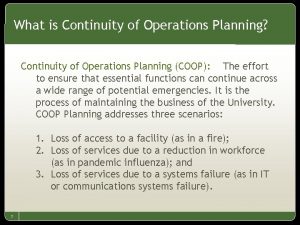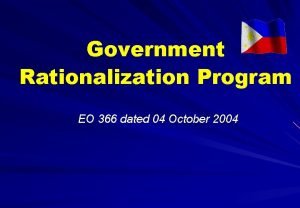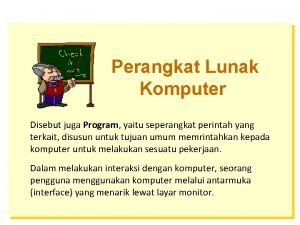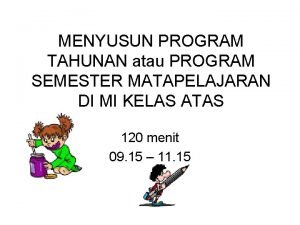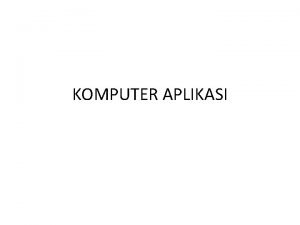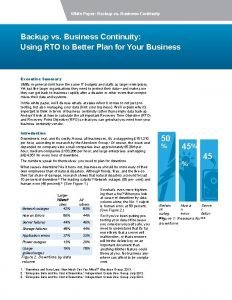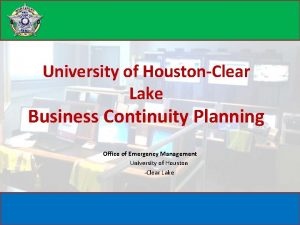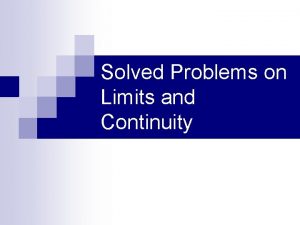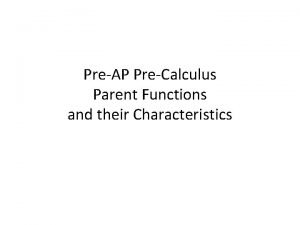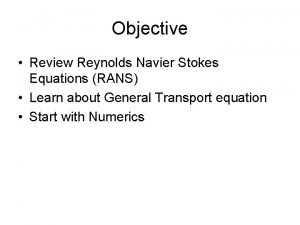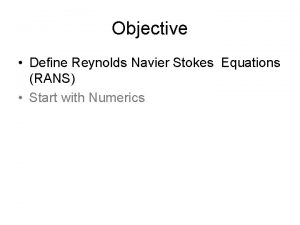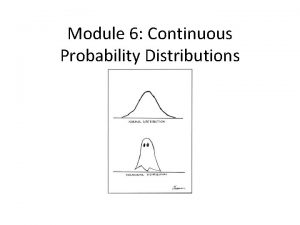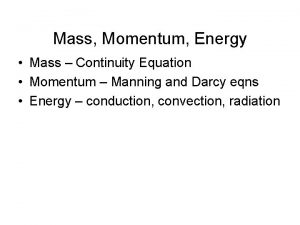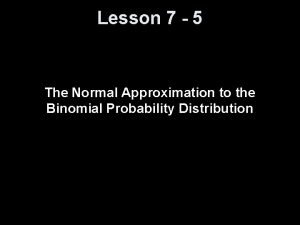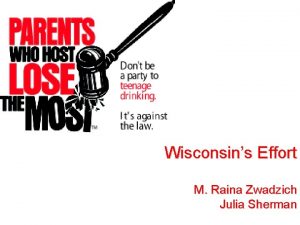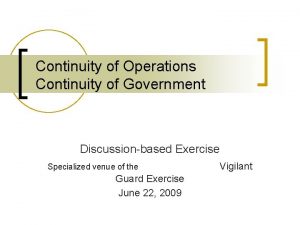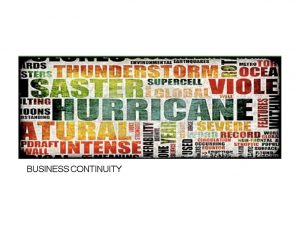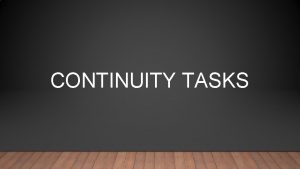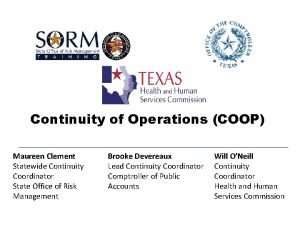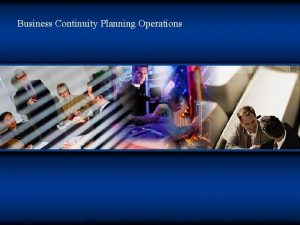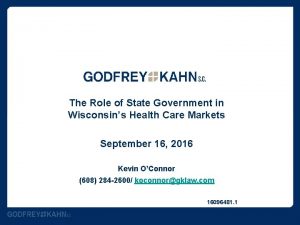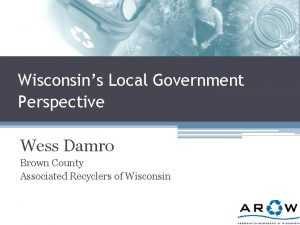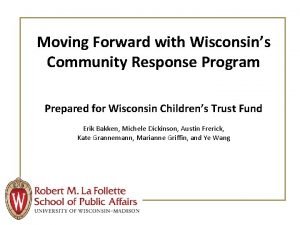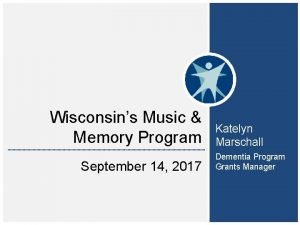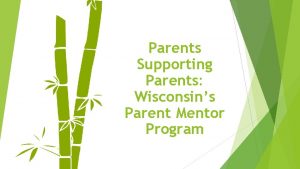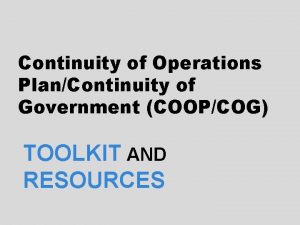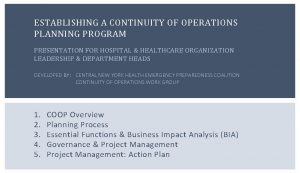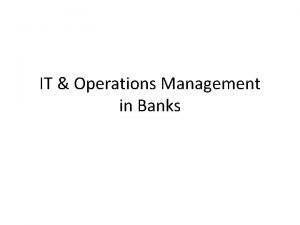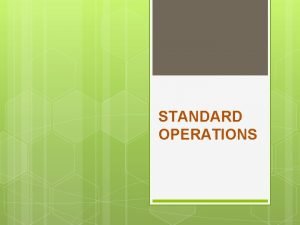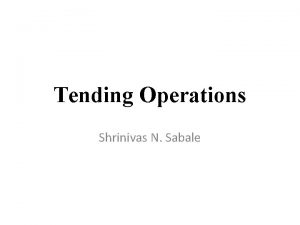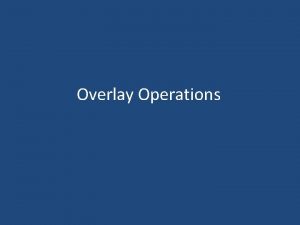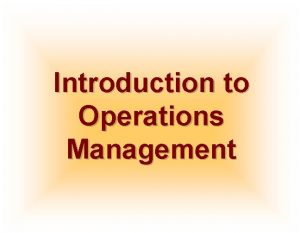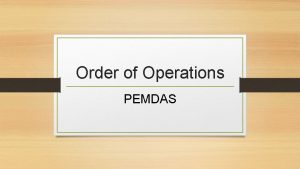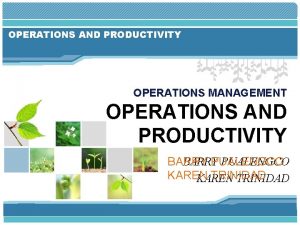Wisconsins Continuity of Operations Continuity of Government Program

























- Slides: 25

Wisconsin’s Continuity of Operations Continuity of Government Program

Wisconsin’s Continuity of Operations Continuity of Government Program n n Definitions Preparedness Basics DOA’s Role and Leadership Recent Pandemic Continuity Preparedness n Current Status n Assistance to the Legislature n Questions

Continuity of Operations (COOP) n Individual state agency readiness to perform time-sensitive business services, likely from a different location, across a wide range of potential emergencies including acts of nature, accidents and technological or attack-related emergencies n Wisconsin’s focus on loss of: u. Use of state agency headquarters, u. Information & communications technology, and/or u. Agency workforce

Time-Sensitive Service n A business service that must be continued or recovered within 30 days of a disruption to normal business operations n Examples: u. State Investment Fund u. Division of Public Health Communicable Disease u. Unemployment Insurance Benefits

Continuity of Government (COG) n Coordinated readiness of all agencies to perform timesensitive business services, across a wide range of potential emergencies including acts of nature, accidents and technological or attack-related emergencies

Risks To continued operation of time-sensitive business services n Fire n Tornado or severe storms n Flooding n Prolonged electrical outages n HVAC or IT equipment failure n Cyber attacks n Pandemic

Readiness Sum of: n Having a plan n Training those who implement the plan n Exercising the plan n Continuous improvement – plan updates u. Personnel and business service changes u. Lessons learned from exercises 4 Progressively more complex

Project Organization n Agencies designate: u. An Agency Continuity Manager & two backups, and u. An Agency Incident Commander & two backups n State Continuity Management Working Group u. Regular monthly meeting u. Training for Continuity Managers & Incident Commanders u. Share best practices u. Agency input

A COOP Plan Describes n Who n Goes where n To do what n When n GOAL - To recover operational capability & continue business service operations n With what resources n And who to communicate and coordinate with

Foundation of Agency Readiness 1. A COOP Plan for Each Service n A Service is 4 A major line of business n Examples: u. Financial Regulation Services u. Electronic Monitoring Center u. Emergency Management u. Animal Disease Management u. Process Tax Returns u. State Data Network 2. And, an umbrella plan for each Agency

COOP Service Plan Describes n Who u. Lists plan lead and backups u. Call tree- all assigned personnel n Where – Alternate site locations n What – Tasklists for each role or team n When – Recovery Timeline lists the sequence of events n What – Resources needed, equipment, vital records, supplies n Who – Key contacts for communications or coordination

Agency COOP Plan Describes n Agency command communications procedures u. Using National Incident Management System (NIMS) protocols n Planning structure and plan maintenance activities n Includes: u. Plan activation procedures u. Call tree u. Alternate site locations u. Lines of succession and delegations of authority

DOA Role and Leadership n In 2004 Governor Doyle directed that DOA lead the effort to improve and strengthen COOP plans n DOA’s Continuity of Government (COG) organization provides leadership, direction, assistance, training and support to Executive Branch agencies to develop, maintain, exercise and coordinate their plans

DOA Role and Leadership n In late 2004 – Spring 2005 DOA COG led development of agency and service COOP plan templates and instructions with input from agencies n Templates were built on best practices, including: u. FEMA COOP guidelines u. National Fire Protection Association (NFPA) 1600 standard u. Disaster Recovery Institute u. National Governor’s Association u. State of Minnesota COOP program

DOA Role and Leadership n DOA COG provided initial orientation and training June 23, 2005 on COOP plan development for approximately: u 110 senior agency managers, and u 220 agency and service COOP planners n Conducted more detailed follow-up training and orientation sessions at virtually all agencies from mid 2005 into 2006 on: u 19 step plan development process u. Use of Living Disaster Recovery Planning Software (LDRPS) COOP software repository for service COOP plans

DOA Role and Leadership n Developed agency level and service level COOP exercise plan templates in 2006 and 2007 for agencies to use in conducting their COOP exercises n Provides on-going consultation, encouragement, and assistance in agency and service plan development, ongoing training and in planning and conducting exercises

Recent Pandemic Continuity Efforts Address the business continuity impact n A pandemic is not just a medical event n It will impact on every organization’s ability to operate w 20% to 40% absentee levels w Potential supply chain impacts w For 6 to 8 to 12 weeks for each wave – potentially two to three waves n Federal pandemic initiates w Major focus – “Sustain Operations of State Agencies & Support and Protect Government Workers”

Wisconsin’s Pandemic COOP Plans n DOA COG developed preparedness and implementation templates based on best practices and with input from DHS and WEM n Implementation task lists become part of agency level and service COOP plans n Templates also developed for each agency location

Wisconsin’s Pandemic COOP Plans n DOA COG developed state-level plans and communications procedures n Most agencies have completed or are completing agency level, service level and site level plans n Together these plans describe how agencies will maintain operations during a pandemic

Current Status n COOP Plans w Three quarters (3/4) of agencies have completed agency level COOP plans w 239 services have completed service level COOP plans n COOP Exercises Held Since 2005 w 39 agency command center COOP exercises w 329 service COOP exercises w 3 state level communication drills

Federal COOP Initiatives n Federal Continuity Directives 1 & 2 for federal agencies u. February 2008 u. Regional COOP teleconferences with State COOP directors to share best practices n Encourage vertical & horizontal integration u. State and local governments u. Private sector critical infrastructure and key resources

Future Steps n Continual improvement of plans n COOP plans for regional and local offices n Promotion of and integration with: u. Local government COOP plans u. Key critical infrastructure & key resource sector continuity plans

Assistance to Legislature n Met with Chief Clerks, offered assistance, templates, instructional materials and training n Participated in planning meetings with Chief Clerks and heads of Legislative Service Agencies n Facilitated COOP plan development stage 1 – identify business services and recovery time objectives with Chief Clerks, Sgt-a-Arms and each Legislative Service Agency

Assistance to Legislature n Conducted COOP stage 2 training u. Dependencies u. Tasks u. Resources u. Communications u. Recovery strategy n Will provide: u Additional plan development training, consultation, assistance as requested u Consultation and/or assistance in planning and conducting exercises as requested

Wisconsin’s Continuity of Operations Continuity of Government Program Questions / Further Information Art Zoellner Continuity of Government Director 608/266 -7532 art. zoellner@wisconsin. gov
 Absolute continuity implies uniform continuity
Absolute continuity implies uniform continuity Continuity of operations planning (coop)
Continuity of operations planning (coop) National powers
National powers A government program for gifted students in the philippines
A government program for gifted students in the philippines Government rationalization program
Government rationalization program Sequential program and an event-driven program?
Sequential program and an event-driven program? Perangkat lunak komputer disebut juga dengan.
Perangkat lunak komputer disebut juga dengan. Menyusun program tahunan dan program semester
Menyusun program tahunan dan program semester Untuk mengakhiri excel dapat menekan tombol
Untuk mengakhiri excel dapat menekan tombol Perangkat keras
Perangkat keras Memulai microsoft word
Memulai microsoft word Business continuity white paper
Business continuity white paper Continuity editing in film
Continuity editing in film Houston business continuity planning
Houston business continuity planning How to write a change and continuity thesis
How to write a change and continuity thesis Lateral continuity
Lateral continuity Limit and continuity solved problems
Limit and continuity solved problems Reynolds transport theorem continuity equation
Reynolds transport theorem continuity equation Pre calc
Pre calc Navier stokes
Navier stokes Navier-stokes equation
Navier-stokes equation Equation of continuity in quantum mechanics
Equation of continuity in quantum mechanics Continuity correction
Continuity correction Mass conservation equation
Mass conservation equation Maxwell
Maxwell Continuity correction
Continuity correction

